Abstract
Liver glycogen formation can occur via the direct (glucose----glucose-6-phosphate----glycogen) or indirect (glucose----C3 compounds----glucose-6-phosphate----glycogen) pathways. In the present study we have examined the effect of hyperglycemia on the pathways of hepatic glycogenesis, estimated from liver uridine diphosphoglucose (UDPglucose) specific activities, and on peripheral (muscle) glucose metabolism in awake, unstressed control and 90% pancreatectomized, diabetic rats. Under identical conditions of hyperinsulinemia (approximately 550 microU/ml), 2-h euglycemic (6 mM) and hyperglycemic (+5.5 mM and +11 mM) clamp studies were performed in combination with [3-3H,U-14C]glucose, [6-3H,U-14C]glucose, or [3-3H]glucose and [U-14C]lactate infusions under postabsorptive conditions. Total body glucose uptake and muscle glycogen synthesis were decreased in diabetic vs. control rats during all the clamp studies, whereas glycolytic rates were similar. By contrast, hyperglycemia determined similar rates of liver glycogen synthesis in both groups. Nevertheless, in diabetic rats, the contribution of the direct pathway to hepatic glycogen repletion was severely decreased, whereas the indirect pathway was markedly increased. After hyperglycemia, hepatic glucose-6-phosphate concentrations were increased in both groups, whereas UDPglucose concentrations were reduced only in the control group. These results indicate that in the diabetic state, under hyperinsulinemic conditions, hyperglycemia normally stimulates liver glycogen synthesis through a marked increase in the indirect pathway, which in turn may compensate for the reduction in the direct pathway. The increase in the hepatic concentrations of both glucose-6-phosphate and UDPglucose suggests the presence, in this diabetic rat model, of a compensatory "push" mechanism for liver glycogen repletion.
Full text
PDF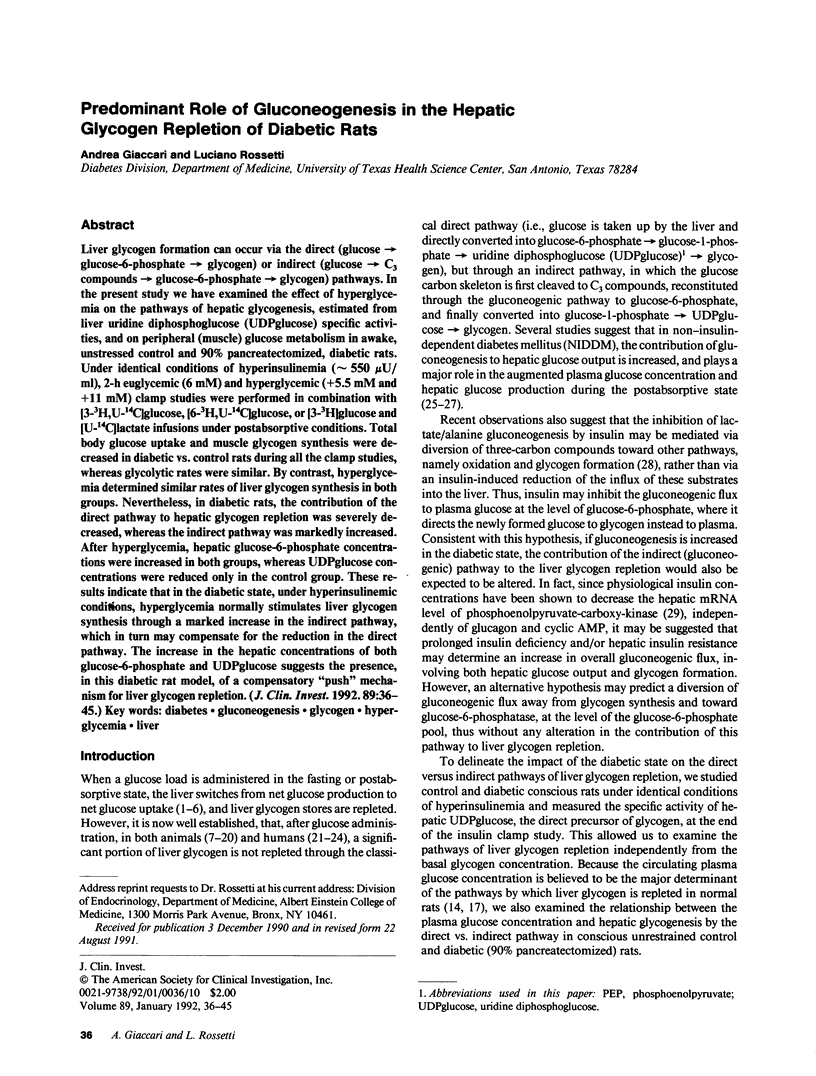
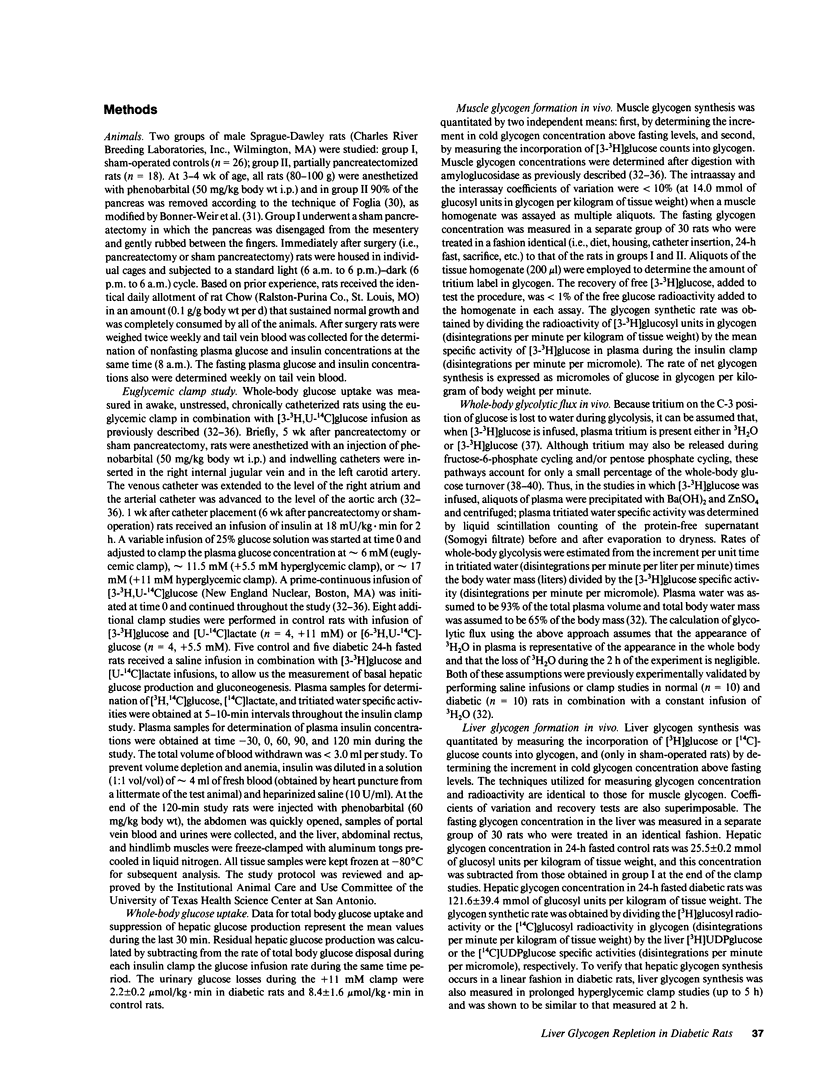
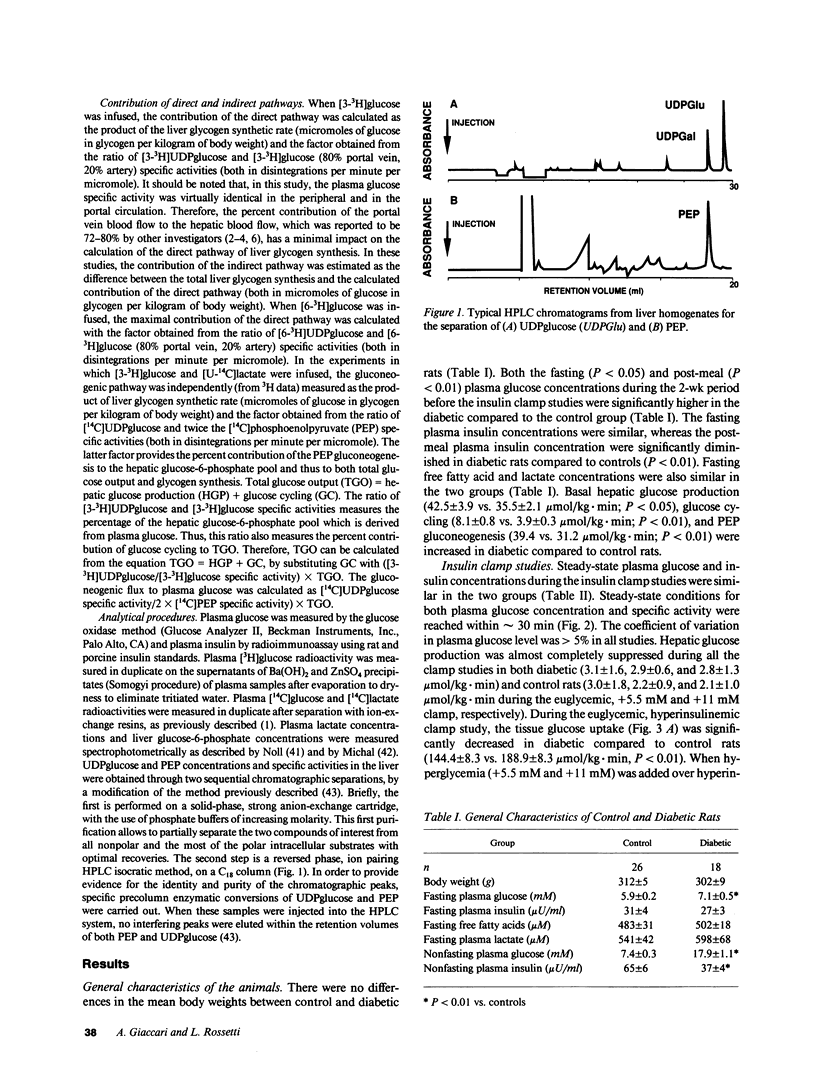
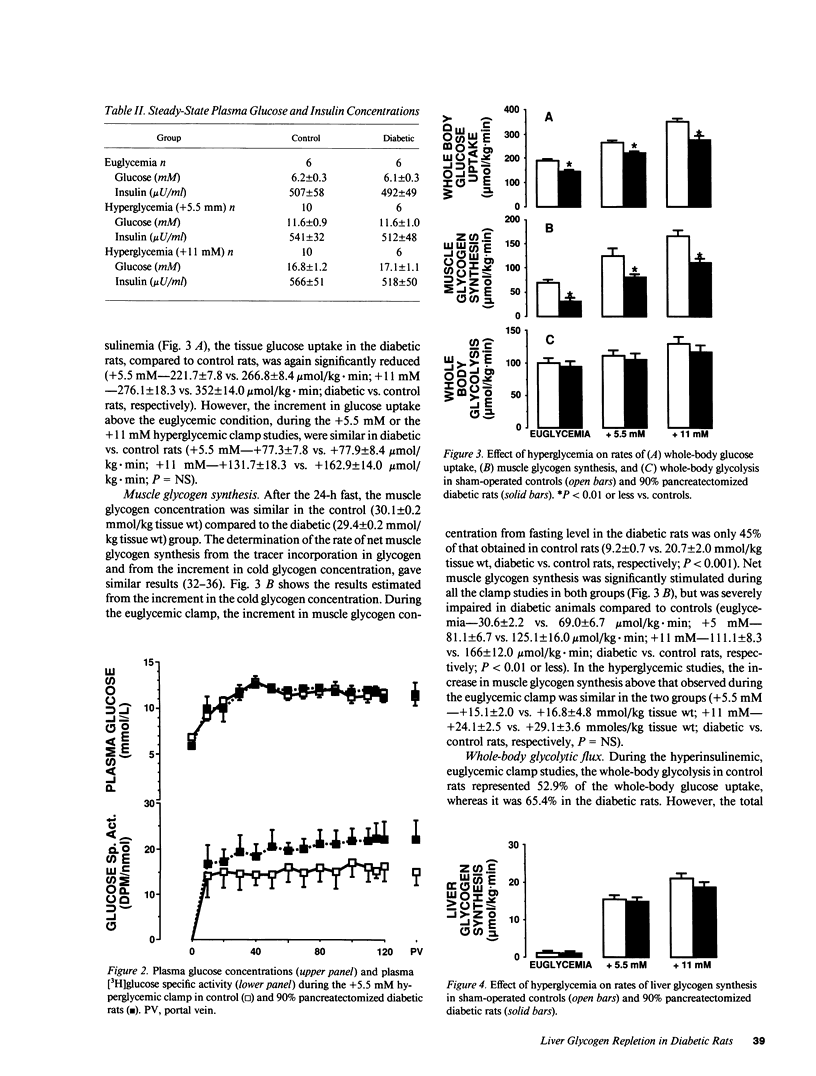
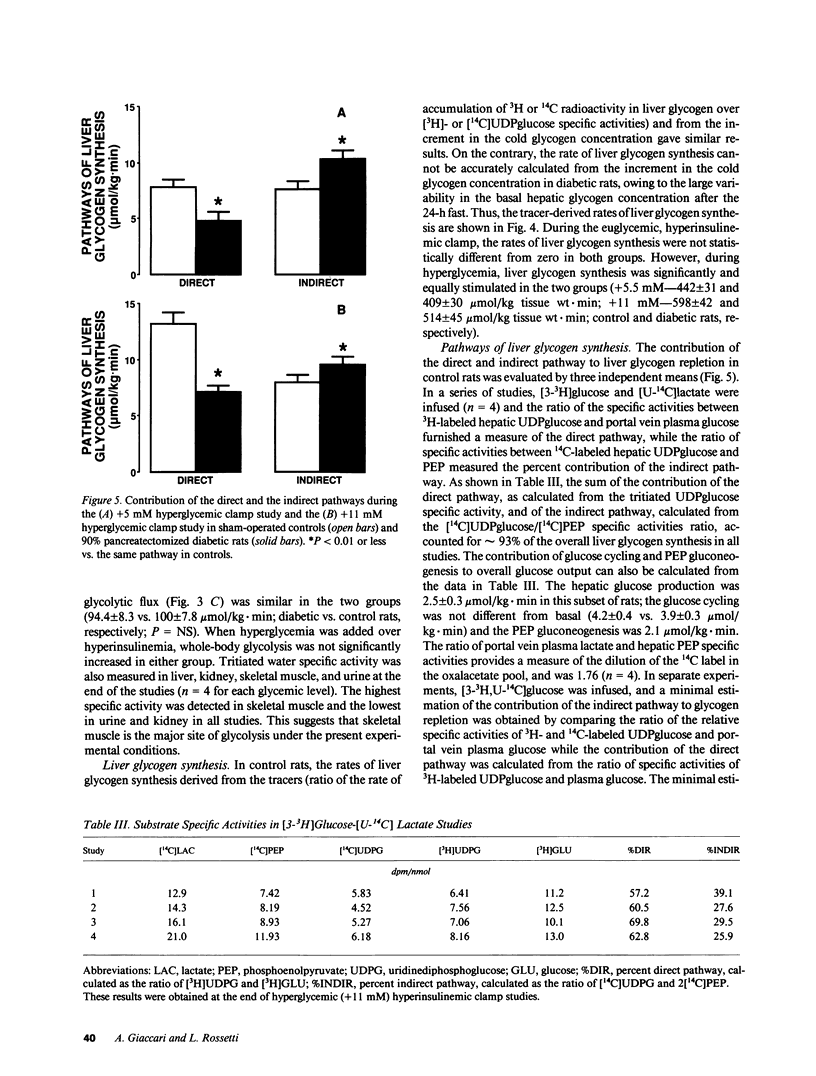
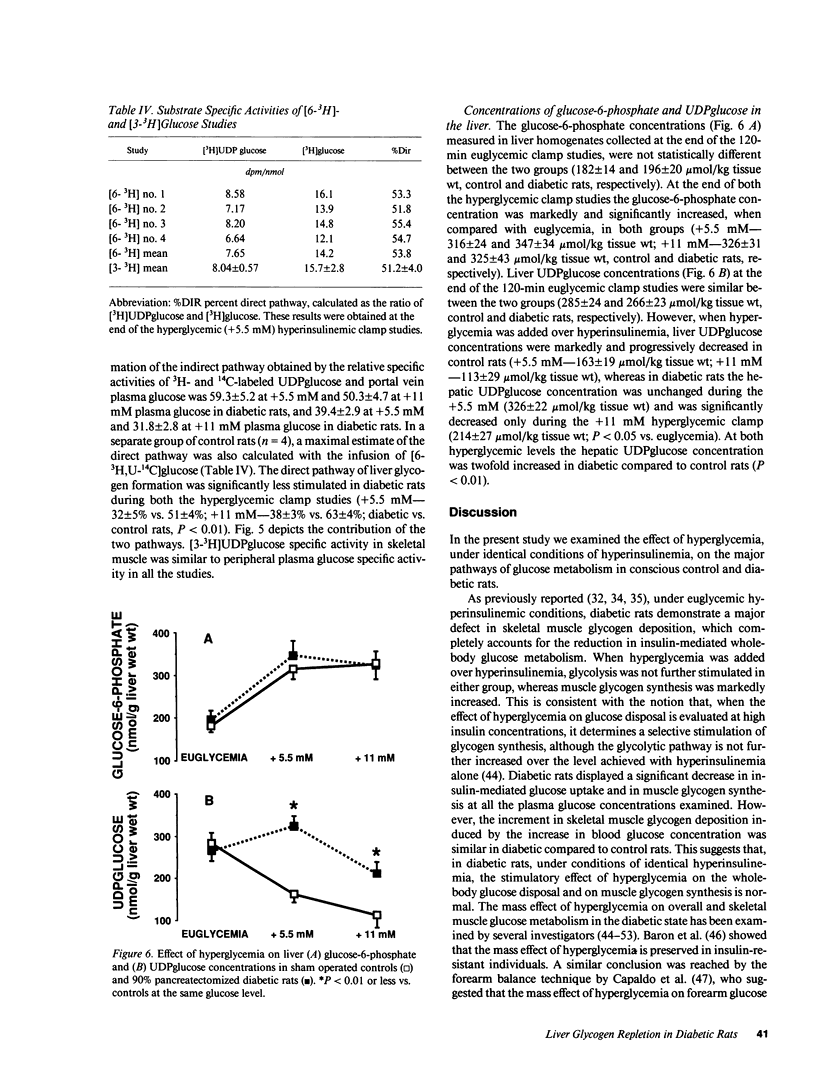
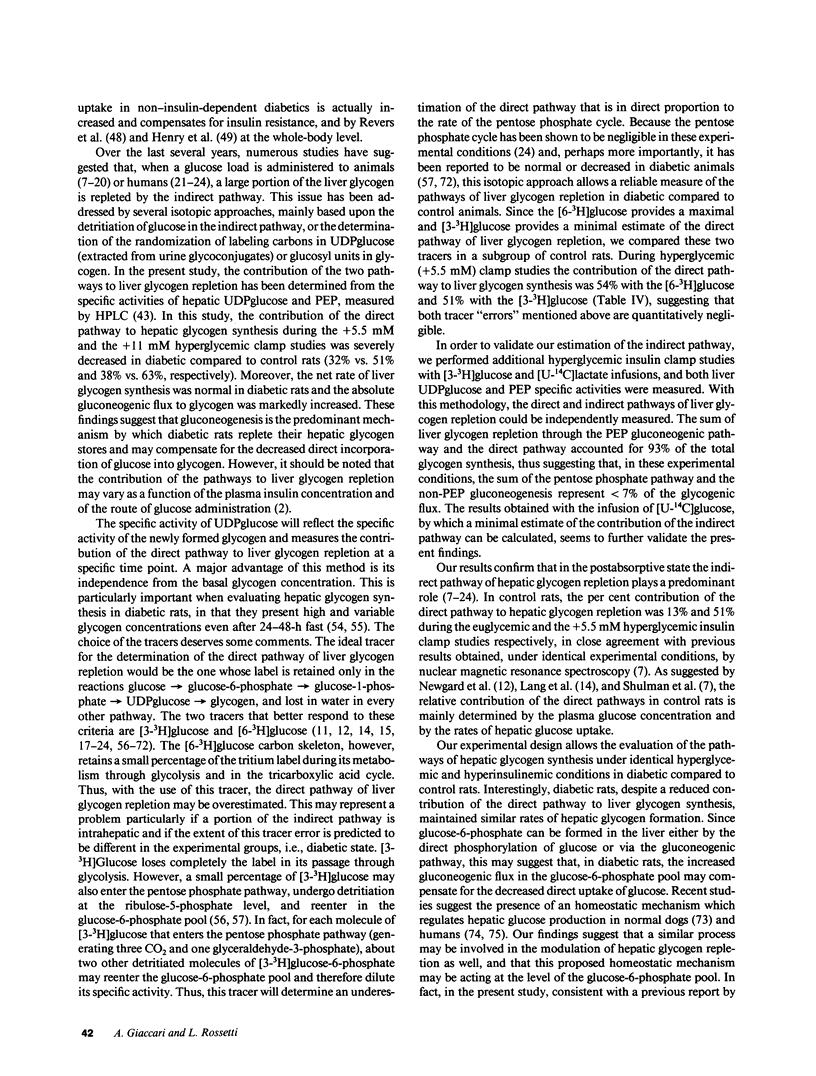
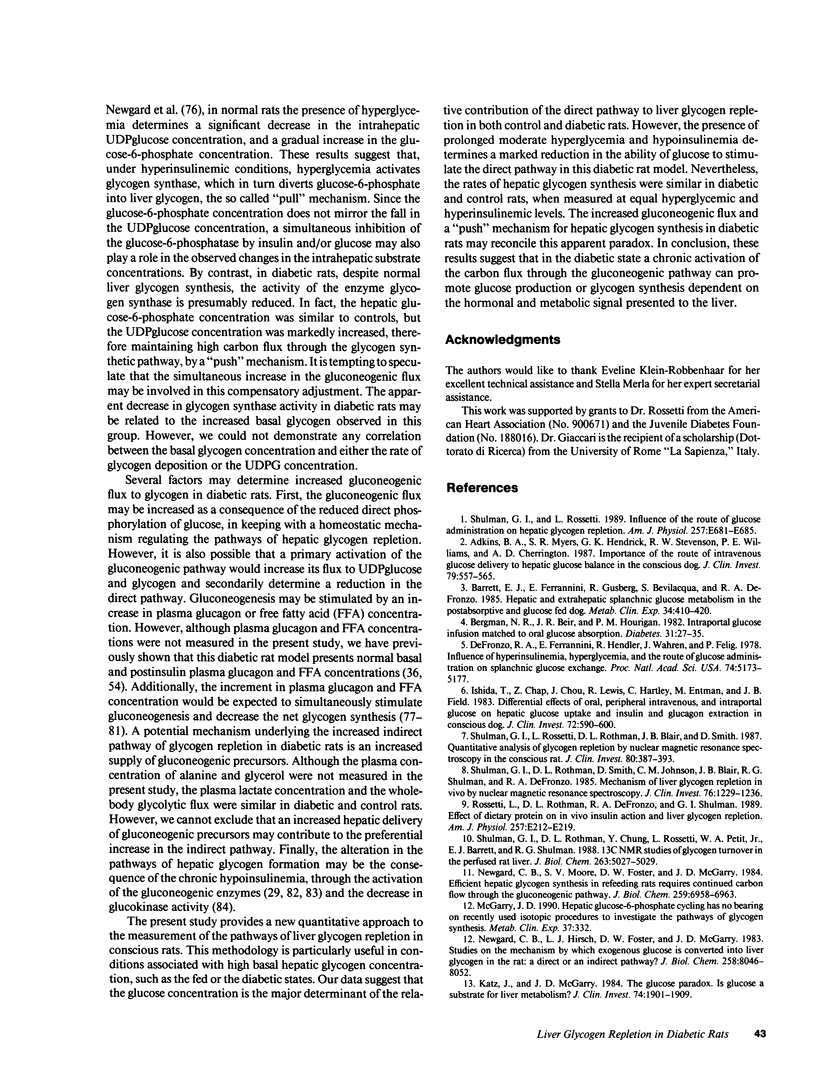
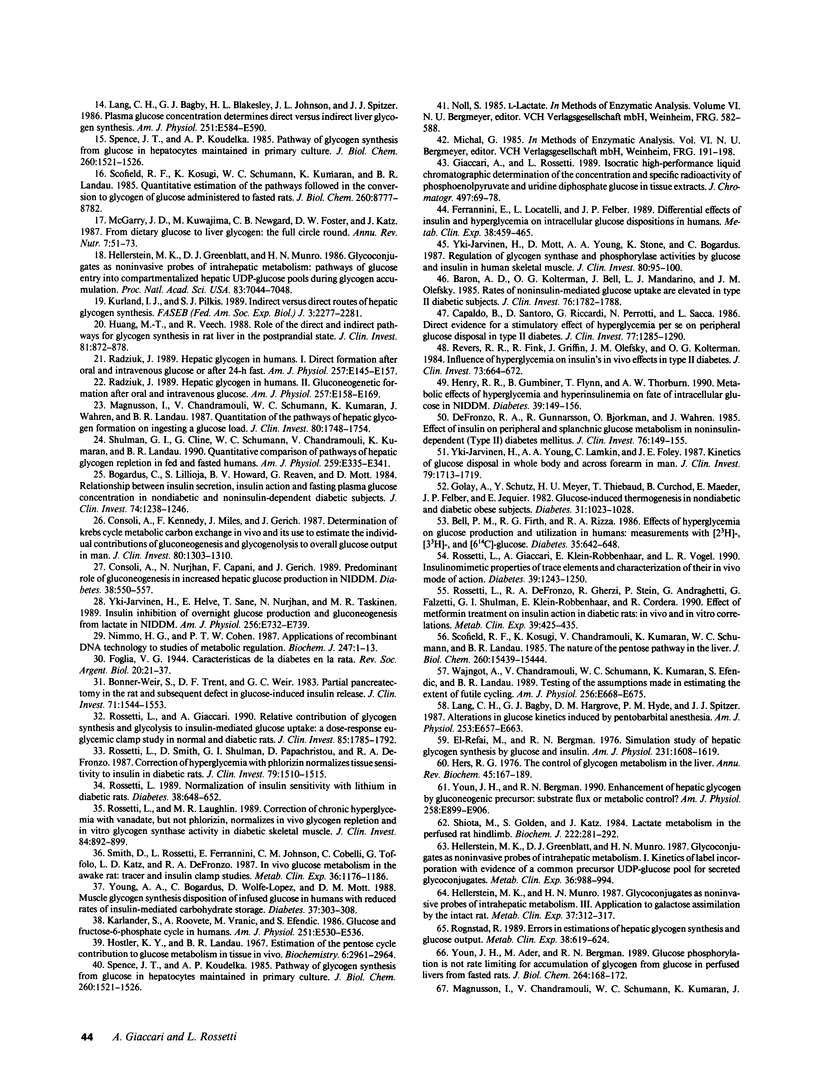
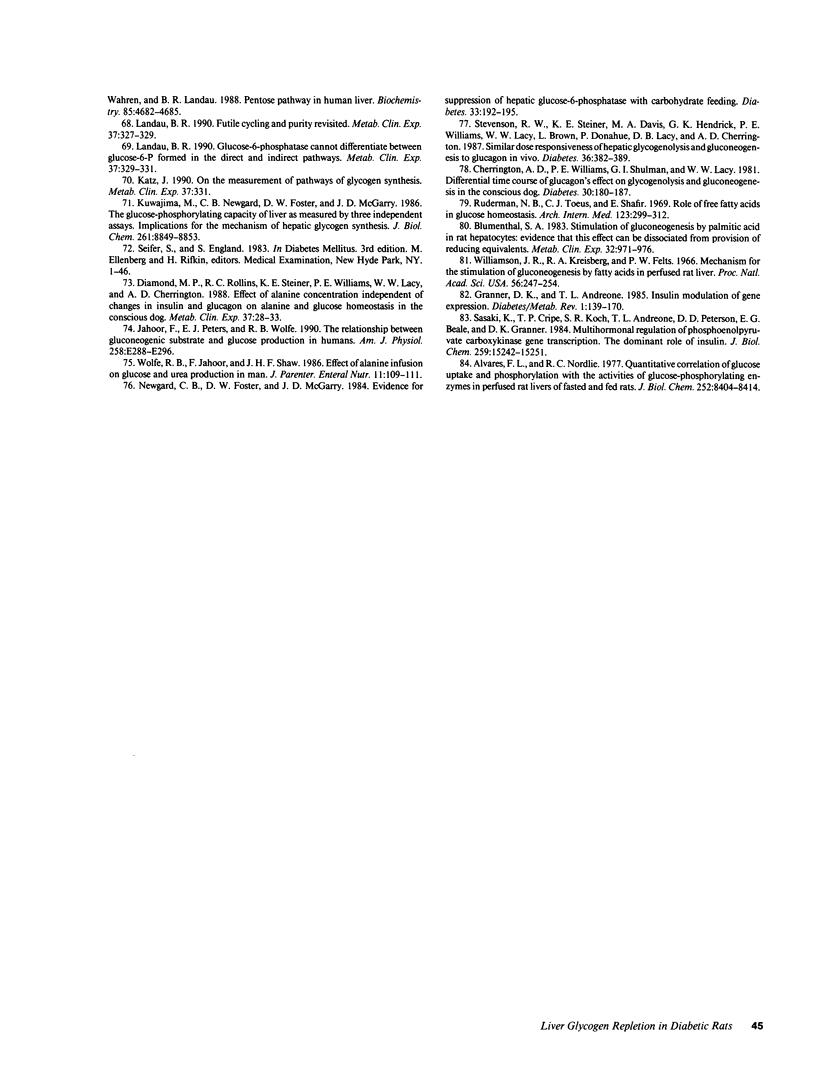
Selected References
These references are in PubMed. This may not be the complete list of references from this article.
- Adkins B. A., Myers S. R., Hendrick G. K., Stevenson R. W., Williams P. E., Cherrington A. D. Importance of the route of intravenous glucose delivery to hepatic glucose balance in the conscious dog. J Clin Invest. 1987 Feb;79(2):557–565. doi: 10.1172/JCI112847. [DOI] [PMC free article] [PubMed] [Google Scholar]
- Alvares F. L., Nordlie R. C. Quantitative correlation of glucose uptake and phosphorylation with the activities of glucose-phosphorylating enzymes in perfused livers of fasted and fed rats. J Biol Chem. 1977 Dec 10;252(23):8404–8414. [PubMed] [Google Scholar]
- Baron A. D., Kolterman O. G., Bell J., Mandarino L. J., Olefsky J. M. Rates of noninsulin-mediated glucose uptake are elevated in type II diabetic subjects. J Clin Invest. 1985 Nov;76(5):1782–1788. doi: 10.1172/JCI112169. [DOI] [PMC free article] [PubMed] [Google Scholar]
- Barrett E. J., Ferrannini E., Gusberg R., Bevilacqua S., DeFronzo R. A. Hepatic and extrahepatic splanchnic glucose metabolism in the postabsorptive and glucose fed dog. Metabolism. 1985 May;34(5):410–420. doi: 10.1016/0026-0495(85)90205-7. [DOI] [PubMed] [Google Scholar]
- Bell P. M., Firth R. G., Rizza R. A. Effects of hyperglycemia on glucose production and utilization in humans. Measurement with [23H]-, [33H]-, and [614C]glucose. Diabetes. 1986 Jun;35(6):642–648. doi: 10.2337/diab.35.6.642. [DOI] [PubMed] [Google Scholar]
- Bergman R. N., Beir J. R., Hourigan P. M. Intraportal glucose infusion matched to oral glucose absorption. Lack of evidence for "gut factor" involvement in hepatic glucose storage. Diabetes. 1982 Jan;31(1):27–35. doi: 10.2337/diab.31.1.27. [DOI] [PubMed] [Google Scholar]
- Blumenthal S. A. Stimulation of gluconeogenesis by palmitic acid in rat hepatocytes: evidence that this effect can be dissociated from the provision of reducing equivalents. Metabolism. 1983 Oct;32(10):971–976. doi: 10.1016/0026-0495(83)90137-3. [DOI] [PubMed] [Google Scholar]
- Bogardus C., Lillioja S., Howard B. V., Reaven G., Mott D. Relationships between insulin secretion, insulin action, and fasting plasma glucose concentration in nondiabetic and noninsulin-dependent diabetic subjects. J Clin Invest. 1984 Oct;74(4):1238–1246. doi: 10.1172/JCI111533. [DOI] [PMC free article] [PubMed] [Google Scholar]
- Bonner-Weir S., Trent D. F., Weir G. C. Partial pancreatectomy in the rat and subsequent defect in glucose-induced insulin release. J Clin Invest. 1983 Jun;71(6):1544–1553. doi: 10.1172/JCI110910. [DOI] [PMC free article] [PubMed] [Google Scholar]
- Capaldo B., Santoro D., Riccardi G., Perrotti N., Saccà L. Direct evidence for a stimulatory effect of hyperglycemia per se on peripheral glucose disposal in type II diabetes. J Clin Invest. 1986 Apr;77(4):1285–1290. doi: 10.1172/JCI112432. [DOI] [PMC free article] [PubMed] [Google Scholar]
- Cherrington A. D., Williams P. E., Shulman G. I., Lacy W. W. Differential time course of glucagon's effect on glycogenolysis and gluconeogenesis in the conscious dog. Diabetes. 1981 Mar;30(3):180–187. doi: 10.2337/diab.30.3.180. [DOI] [PubMed] [Google Scholar]
- Consoli A., Kennedy F., Miles J., Gerich J. Determination of Krebs cycle metabolic carbon exchange in vivo and its use to estimate the individual contributions of gluconeogenesis and glycogenolysis to overall glucose output in man. J Clin Invest. 1987 Nov;80(5):1303–1310. doi: 10.1172/JCI113206. [DOI] [PMC free article] [PubMed] [Google Scholar]
- Consoli A., Nurjhan N., Capani F., Gerich J. Predominant role of gluconeogenesis in increased hepatic glucose production in NIDDM. Diabetes. 1989 May;38(5):550–557. doi: 10.2337/diab.38.5.550. [DOI] [PubMed] [Google Scholar]
- DeFronzo R. A., Ferrannini E., Hendler R., Wahren J., Felig P. Influence of hyperinsulinemia, hyperglycemia, and the route of glucose administration on splanchnic glucose exchange. Proc Natl Acad Sci U S A. 1978 Oct;75(10):5173–5177. doi: 10.1073/pnas.75.10.5173. [DOI] [PMC free article] [PubMed] [Google Scholar]
- DeFronzo R. A., Gunnarsson R., Björkman O., Olsson M., Wahren J. Effects of insulin on peripheral and splanchnic glucose metabolism in noninsulin-dependent (type II) diabetes mellitus. J Clin Invest. 1985 Jul;76(1):149–155. doi: 10.1172/JCI111938. [DOI] [PMC free article] [PubMed] [Google Scholar]
- Diamond M. P., Rollings R. C., Steiner K. E., Williams P. E., Lacy W. W., Cherrington A. D. Effect of alanine concentration independent of changes in insulin and glucagon on alanine and glucose homeostasis in the conscious dog. Metabolism. 1988 Jan;37(1):28–33. doi: 10.1016/0026-0495(88)90025-x. [DOI] [PubMed] [Google Scholar]
- El-Refai M., Bergman R. N. Simulation study of control of hepatic glycogen synthesis by glucose and insulin. Am J Physiol. 1976 Nov;231(5 Pt 1):1608–1619. doi: 10.1152/ajplegacy.1976.231.5.1608. [DOI] [PubMed] [Google Scholar]
- Ferrannini E., Locatelli L., Jequier E., Felber J. P. Differential effects of insulin and hyperglycemia on intracellular glucose disposition in humans. Metabolism. 1989 May;38(5):459–465. doi: 10.1016/0026-0495(89)90199-6. [DOI] [PubMed] [Google Scholar]
- Giaccari A., Rossetti L. Isocratic high-performance liquid chromatographic determination of the concentration and specific radioactivity of phosphoenolpyruvate and uridine diphosphate glucose in tissue extracts. J Chromatogr. 1989 Dec 29;497:69–78. doi: 10.1016/0378-4347(89)80006-4. [DOI] [PubMed] [Google Scholar]
- Golay A., Schutz Y., Meyer H. U., Thiébaud D., Curchod B., Maeder E., Felber J. P., Jéquier E. Glucose-induced thermogenesis in nondiabetic and diabetic obese subjects. Diabetes. 1982 Nov;31(11):1023–1028. doi: 10.2337/diacare.31.11.1023. [DOI] [PubMed] [Google Scholar]
- Granner D. K., Andreone T. L. Insulin modulation of gene expression. Diabetes Metab Rev. 1985;1(1-2):139–170. doi: 10.1002/dmr.5610010108. [DOI] [PubMed] [Google Scholar]
- Hellerstein M. K., Greenblatt D. J., Munro H. N. Glycoconjugates as noninvasive probes of intrahepatic metabolism: I. Kinetics of label incorporation with evidence of a common precursor UDP-glucose pool for secreted glycoconjugates. Metabolism. 1987 Oct;36(10):988–994. doi: 10.1016/0026-0495(87)90138-7. [DOI] [PubMed] [Google Scholar]
- Hellerstein M. K., Greenblatt D. J., Munro H. N. Glycoconjugates as noninvasive probes of intrahepatic metabolism: pathways of glucose entry into compartmentalized hepatic UDP-glucose pools during glycogen accumulation. Proc Natl Acad Sci U S A. 1986 Sep;83(18):7044–7048. doi: 10.1073/pnas.83.18.7044. [DOI] [PMC free article] [PubMed] [Google Scholar]
- Hellerstein M. K., Munro H. N. Glycoconjugates as noninvasive probes of intrahepatic metabolism: III. Application to galactose assimilation by the intact rat. Metabolism. 1988 Apr;37(4):312–317. doi: 10.1016/0026-0495(88)90129-1. [DOI] [PubMed] [Google Scholar]
- Henry R. R., Gumbiner B., Flynn T., Thorburn A. W. Metabolic effects of hyperglycemia and hyperinsulinemia on fate of intracellular glucose in NIDDM. Diabetes. 1990 Feb;39(2):149–156. doi: 10.2337/diab.39.2.149. [DOI] [PubMed] [Google Scholar]
- Hers H. G. The control of glycogen metabolism in the liver. Annu Rev Biochem. 1976;45:167–189. doi: 10.1146/annurev.bi.45.070176.001123. [DOI] [PubMed] [Google Scholar]
- Hostetler K. Y., Landau B. R. Estimation of the pentose cycle contribution to glucose metabolism in tissue in vivo. Biochemistry. 1967 Oct;6(10):2961–2964. doi: 10.1021/bi00862a001. [DOI] [PubMed] [Google Scholar]
- Huang M. T., Veech R. L. Role of the direct and indirect pathways for glycogen synthesis in rat liver in the postprandial state. J Clin Invest. 1988 Mar;81(3):872–878. doi: 10.1172/JCI113397. [DOI] [PMC free article] [PubMed] [Google Scholar]
- Ishida T., Chap Z., Chou J., Lewis R., Hartley C., Entman M., Field J. B. Differential effects of oral, peripheral intravenous, and intraportal glucose on hepatic glucose uptake and insulin and glucagon extraction in conscious dogs. J Clin Invest. 1983 Aug;72(2):590–601. doi: 10.1172/JCI111007. [DOI] [PMC free article] [PubMed] [Google Scholar]
- Jahoor F., Peters E. J., Wolfe R. R. The relationship between gluconeogenic substrate supply and glucose production in humans. Am J Physiol. 1990 Feb;258(2 Pt 1):E288–E296. doi: 10.1152/ajpendo.1990.258.2.E288. [DOI] [PubMed] [Google Scholar]
- Karlander S., Roovete A., Vranić M., Efendić S. Glucose and fructose 6-phosphate cycle in humans. Am J Physiol. 1986 Nov;251(5 Pt 1):E530–E536. doi: 10.1152/ajpendo.1986.251.5.E530. [DOI] [PubMed] [Google Scholar]
- Katz J., McGarry J. D. The glucose paradox. Is glucose a substrate for liver metabolism? J Clin Invest. 1984 Dec;74(6):1901–1909. doi: 10.1172/JCI111610. [DOI] [PMC free article] [PubMed] [Google Scholar]
- Katz J. On the measurement of pathways of glycogen synthesis. Metabolism. 1990 Mar;39(3):331–332. doi: 10.1016/0026-0495(90)90058-k. [DOI] [PubMed] [Google Scholar]
- Kurland I. J., Pilkis S. J. Indirect versus direct routes of hepatic glycogen synthesis. FASEB J. 1989 Sep;3(11):2277–2281. doi: 10.1096/fasebj.3.11.2673899. [DOI] [PubMed] [Google Scholar]
- Kuwajima M., Newgard C. B., Foster D. W., McGarry J. D. The glucose-phosphorylating capacity of liver as measured by three independent assays. Implications for the mechanism of hepatic glycogen synthesis. J Biol Chem. 1986 Jul 5;261(19):8849–8853. [PubMed] [Google Scholar]
- Landau B. R. Futile cycling and purity revisited. Metabolism. 1990 Mar;39(3):327–329. doi: 10.1016/0026-0495(90)90055-h. [DOI] [PubMed] [Google Scholar]
- Landau B. R. Glucose-6-phosphatase cannot differentiate between glucose-6-P formed in the direct and indirect pathways. Metabolism. 1990 Mar;39(3):329–331. doi: 10.1016/0026-0495(90)90057-j. [DOI] [PubMed] [Google Scholar]
- Lang C. H., Bagby G. J., Blakesley H. L., Johnson J. L., Spitzer J. J. Plasma glucose concentration determines direct versus indirect liver glycogen synthesis. Am J Physiol. 1986 Nov;251(5 Pt 1):E584–E590. doi: 10.1152/ajpendo.1986.251.5.E584. [DOI] [PubMed] [Google Scholar]
- Lang C. H., Bagby G. J., Hargrove D. M., Hyde P. M., Spitzer J. J. Alterations in glucose kinetics induced by pentobarbital anesthesia. Am J Physiol. 1987 Dec;253(6 Pt 1):E657–E663. doi: 10.1152/ajpendo.1987.253.6.E657. [DOI] [PubMed] [Google Scholar]
- Magnusson I., Chandramouli V., Schumann W. C., Kumaran K., Wahren J., Landau B. R. Quantitation of the pathways of hepatic glycogen formation on ingesting a glucose load. J Clin Invest. 1987 Dec;80(6):1748–1754. doi: 10.1172/JCI113267. [DOI] [PMC free article] [PubMed] [Google Scholar]
- McGarry J. D. Hepatic glucose-6-phosphate cycling has no bearing on recently used isotopic procedures to investigate the pathways of glycogen synthesis. Metabolism. 1990 Mar;39(3):332–333. doi: 10.1016/0026-0495(90)90059-l. [DOI] [PubMed] [Google Scholar]
- McGarry J. D., Kuwajima M., Newgard C. B., Foster D. W., Katz J. From dietary glucose to liver glycogen: the full circle round. Annu Rev Nutr. 1987;7:51–73. doi: 10.1146/annurev.nu.07.070187.000411. [DOI] [PubMed] [Google Scholar]
- Newgard C. B., Foster D. W., McGarry J. D. Evidence for suppression of hepatic glucose-6-phosphatase with carbohydrate feeding. Diabetes. 1984 Feb;33(2):192–195. doi: 10.2337/diab.33.2.192. [DOI] [PubMed] [Google Scholar]
- Newgard C. B., Hirsch L. J., Foster D. W., McGarry J. D. Studies on the mechanism by which exogenous glucose is converted into liver glycogen in the rat. A direct or an indirect pathway? J Biol Chem. 1983 Jul 10;258(13):8046–8052. [PubMed] [Google Scholar]
- Newgard C. B., Moore S. V., Foster D. W., McGarry J. D. Efficient hepatic glycogen synthesis in refeeding rats requires continued carbon flow through the gluconeogenic pathway. J Biol Chem. 1984 Jun 10;259(11):6958–6963. [PubMed] [Google Scholar]
- Nimmo H. G., Cohen P. T. Applications of recombinant DNA technology to studies of metabolic regulation. Biochem J. 1987 Oct 1;247(1):1–13. doi: 10.1042/bj2470001. [DOI] [PMC free article] [PubMed] [Google Scholar]
- Radziuk J. Hepatic glycogen in humans. I. Direct formation after oral and intravenous glucose or after a 24-h fast. Am J Physiol. 1989 Aug;257(2 Pt 1):E145–E157. doi: 10.1152/ajpendo.1989.257.2.E145. [DOI] [PubMed] [Google Scholar]
- Radziuk J. Hepatic glycogen in humans. II. Gluconeogenetic formation after oral and intravenous glucose. Am J Physiol. 1989 Aug;257(2 Pt 1):E158–E169. doi: 10.1152/ajpendo.1989.257.2.E158. [DOI] [PubMed] [Google Scholar]
- Revers R. R., Fink R., Griffin J., Olefsky J. M., Kolterman O. G. Influence of hyperglycemia on insulin's in vivo effects in type II diabetes. J Clin Invest. 1984 Mar;73(3):664–672. doi: 10.1172/JCI111258. [DOI] [PMC free article] [PubMed] [Google Scholar]
- Rognstad R. Errors in the isotopic estimations of hepatic glycogen synthesis and glucose output. Metabolism. 1989 Jul;38(7):619–624. doi: 10.1016/0026-0495(89)90097-8. [DOI] [PubMed] [Google Scholar]
- Rossetti L., DeFronzo R. A., Gherzi R., Stein P., Andraghetti G., Falzetti G., Shulman G. I., Klein-Robbenhaar E., Cordera R. Effect of metformin treatment on insulin action in diabetic rats: in vivo and in vitro correlations. Metabolism. 1990 Apr;39(4):425–435. doi: 10.1016/0026-0495(90)90259-f. [DOI] [PubMed] [Google Scholar]
- Rossetti L., Giaccari A., Klein-Robbenhaar E., Vogel L. R. Insulinomimetic properties of trace elements and characterization of their in vivo mode of action. Diabetes. 1990 Oct;39(10):1243–1250. doi: 10.2337/diab.39.10.1243. [DOI] [PubMed] [Google Scholar]
- Rossetti L., Giaccari A. Relative contribution of glycogen synthesis and glycolysis to insulin-mediated glucose uptake. A dose-response euglycemic clamp study in normal and diabetic rats. J Clin Invest. 1990 Jun;85(6):1785–1792. doi: 10.1172/JCI114636. [DOI] [PMC free article] [PubMed] [Google Scholar]
- Rossetti L., Lauglin M. R. Correction of chronic hyperglycemia with vanadate, but not with phlorizin, normalizes in vivo glycogen repletion and in vitro glycogen synthase activity in diabetic skeletal muscle. J Clin Invest. 1989 Sep;84(3):892–899. doi: 10.1172/JCI114250. [DOI] [PMC free article] [PubMed] [Google Scholar]
- Rossetti L. Normalization of insulin sensitivity with lithium in diabetic rats. Diabetes. 1989 May;38(5):648–652. doi: 10.2337/diab.38.5.648. [DOI] [PubMed] [Google Scholar]
- Rossetti L., Rothman D. L., DeFronzo R. A., Shulman G. I. Effect of dietary protein on in vivo insulin action and liver glycogen repletion. Am J Physiol. 1989 Aug;257(2 Pt 1):E212–E219. doi: 10.1152/ajpendo.1989.257.2.E212. [DOI] [PubMed] [Google Scholar]
- Rossetti L., Smith D., Shulman G. I., Papachristou D., DeFronzo R. A. Correction of hyperglycemia with phlorizin normalizes tissue sensitivity to insulin in diabetic rats. J Clin Invest. 1987 May;79(5):1510–1515. doi: 10.1172/JCI112981. [DOI] [PMC free article] [PubMed] [Google Scholar]
- Ruderman N. B., Toews C. J., Shafrir E. Role of free fatty acids in glucose homeostasis. Arch Intern Med. 1969 Mar;123(3):299–313. [PubMed] [Google Scholar]
- Sasaki K., Cripe T. P., Koch S. R., Andreone T. L., Petersen D. D., Beale E. G., Granner D. K. Multihormonal regulation of phosphoenolpyruvate carboxykinase gene transcription. The dominant role of insulin. J Biol Chem. 1984 Dec 25;259(24):15242–15251. [PubMed] [Google Scholar]
- Scofield R. F., Kosugi K., Chandramouli V., Kumaran K., Schumann W. C., Landau B. R. The nature of the pentose pathway in liver. J Biol Chem. 1985 Dec 15;260(29):15439–15444. [PubMed] [Google Scholar]
- Scofield R. F., Kosugi K., Schumann W. C., Kumaran K., Landau B. R. Quantitative estimation of the pathways followed in the conversion to glycogen of glucose administered to the fasted rat. J Biol Chem. 1985 Jul 25;260(15):8777–8782. [PubMed] [Google Scholar]
- Shiota M., Golden S., Katz J. Lactate metabolism in the perfused rat hindlimb. Biochem J. 1984 Sep 1;222(2):281–292. doi: 10.1042/bj2220281. [DOI] [PMC free article] [PubMed] [Google Scholar]
- Shulman G. I., Cline G., Schumann W. C., Chandramouli V., Kumaran K., Landau B. R. Quantitative comparison of pathways of hepatic glycogen repletion in fed and fasted humans. Am J Physiol. 1990 Sep;259(3 Pt 1):E335–E341. doi: 10.1152/ajpendo.1990.259.3.E335. [DOI] [PubMed] [Google Scholar]
- Shulman G. I., Rossetti L. Influence of the route of glucose administration on hepatic glycogen repletion. Am J Physiol. 1989 Nov;257(5 Pt 1):E681–E685. doi: 10.1152/ajpendo.1989.257.5.E681. [DOI] [PubMed] [Google Scholar]
- Shulman G. I., Rossetti L., Rothman D. L., Blair J. B., Smith D. Quantitative analysis of glycogen repletion by nuclear magnetic resonance spectroscopy in the conscious rat. J Clin Invest. 1987 Aug;80(2):387–393. doi: 10.1172/JCI113084. [DOI] [PMC free article] [PubMed] [Google Scholar]
- Shulman G. I., Rothman D. L., Chung Y., Rossetti L., Petit W. A., Jr, Barrett E. J., Shulman R. G. 13C NMR studies of glycogen turnover in the perfused rat liver. J Biol Chem. 1988 Apr 15;263(11):5027–5029. [PubMed] [Google Scholar]
- Shulman G. I., Rothman D. L., Smith D., Johnson C. M., Blair J. B., Shulman R. G., DeFronzo R. A. Mechanism of liver glycogen repletion in vivo by nuclear magnetic resonance spectroscopy. J Clin Invest. 1985 Sep;76(3):1229–1236. doi: 10.1172/JCI112078. [DOI] [PMC free article] [PubMed] [Google Scholar]
- Spence J. T., Koudelka A. P. Pathway of glycogen synthesis from glucose in hepatocytes maintained in primary culture. J Biol Chem. 1985 Feb 10;260(3):1521–1526. [PubMed] [Google Scholar]
- Spence J. T., Koudelka A. P. Pathway of glycogen synthesis from glucose in hepatocytes maintained in primary culture. J Biol Chem. 1985 Feb 10;260(3):1521–1526. [PubMed] [Google Scholar]
- Stevenson R. W., Steiner K. E., Davis M. A., Hendrick G. K., Williams P. E., Lacy W. W., Brown L., Donahue P., Lacy D. B., Cherrington A. D. Similar dose responsiveness of hepatic glycogenolysis and gluconeogenesis to glucagon in vivo. Diabetes. 1987 Mar;36(3):382–389. doi: 10.2337/diab.36.3.382. [DOI] [PubMed] [Google Scholar]
- Wajngot A., Chandramouli V., Schumann W. C., Kumaran K., Efendić S., Landau B. R. Testing of the assumptions made in estimating the extent of futile cycling. Am J Physiol. 1989 May;256(5 Pt 1):E668–E675. doi: 10.1152/ajpendo.1989.256.5.E668. [DOI] [PubMed] [Google Scholar]
- Williamson J. R., Kreisberg R. A., Felts P. W. Mechanism for the stimulation of gluconeogenesis by fatty acids in perfused rat liver. Proc Natl Acad Sci U S A. 1966 Jul;56(1):247–254. doi: 10.1073/pnas.56.1.247. [DOI] [PMC free article] [PubMed] [Google Scholar]
- Wolfe R. R., Jahoor F., Shaw J. H. Effect of alanine infusion on glucose and urea production in man. JPEN J Parenter Enteral Nutr. 1987 Mar-Apr;11(2):109–111. doi: 10.1177/0148607187011002109. [DOI] [PubMed] [Google Scholar]
- Yki-Järvinen H., Helve E., Sane T., Nurjhan N., Taskinen M. R. Insulin inhibition of overnight glucose production and gluconeogenesis from lactate in NIDDM. Am J Physiol. 1989 Jun;256(6 Pt 1):E732–E739. doi: 10.1152/ajpendo.1989.256.6.E732. [DOI] [PubMed] [Google Scholar]
- Yki-Järvinen H., Mott D., Young A. A., Stone K., Bogardus C. Regulation of glycogen synthase and phosphorylase activities by glucose and insulin in human skeletal muscle. J Clin Invest. 1987 Jul;80(1):95–100. doi: 10.1172/JCI113069. [DOI] [PMC free article] [PubMed] [Google Scholar]
- Yki-Järvinen H., Young A. A., Lamkin C., Foley J. E. Kinetics of glucose disposal in whole body and across the forearm in man. J Clin Invest. 1987 Jun;79(6):1713–1719. doi: 10.1172/JCI113011. [DOI] [PMC free article] [PubMed] [Google Scholar]
- Youn J. H., Ader M., Bergman R. N. Glucose phosphorylation is not rate limiting for accumulation of glycogen from glucose in perfused livers from fasted rats. J Biol Chem. 1989 Jan 5;264(1):168–172. [PubMed] [Google Scholar]
- Youn J. H., Bergman R. N. Enhancement of hepatic glycogen by gluconeogenic precursors: substrate flux or metabolic control? Am J Physiol. 1990 Jun;258(6 Pt 1):E899–E906. doi: 10.1152/ajpendo.1990.258.6.E899. [DOI] [PubMed] [Google Scholar]
- Young A. A., Bogardus C., Wolfe-Lopez D., Mott D. M. Muscle glycogen synthesis and disposition of infused glucose in humans with reduced rates of insulin-mediated carbohydrate storage. Diabetes. 1988 Mar;37(3):303–308. doi: 10.2337/diab.37.3.303. [DOI] [PubMed] [Google Scholar]


